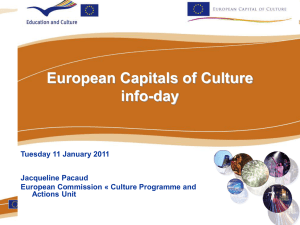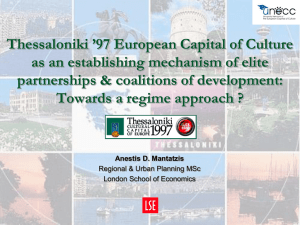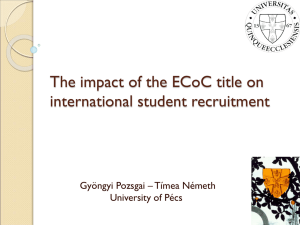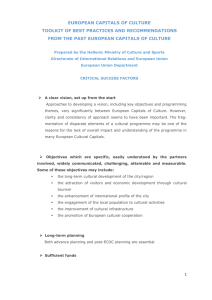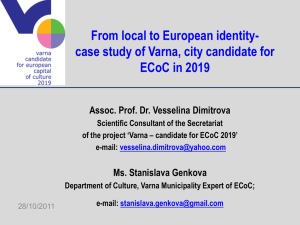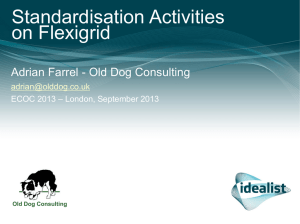European Capitals of Culture 2020 to 2033 A guide for cities
advertisement
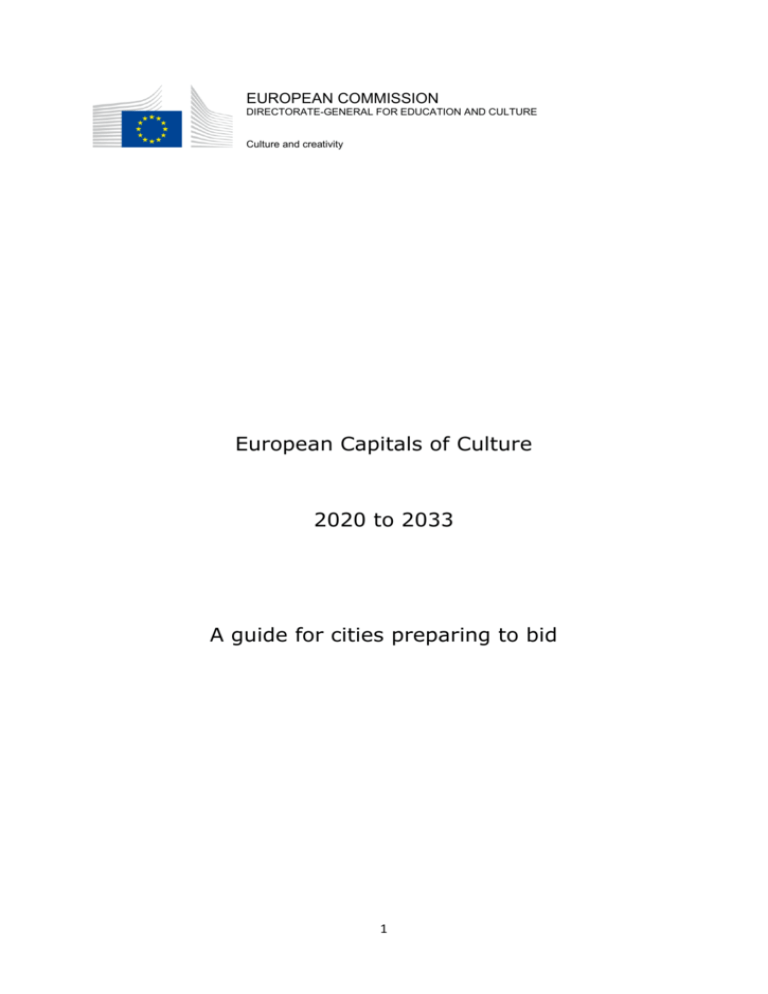
EUROPEAN COMMISSION DIRECTORATE-GENERAL FOR EDUCATION AND CULTURE Culture and creativity European Capitals of Culture 2020 to 2033 A guide for cities preparing to bid 1 Introduction This guide explains the process and criteria for the European Capitals of Culture (ECOC) action from 2020 to 2033. It is aimed at cities considering making a bid and for preparing their bid. There are two documents which are required reading with this guide. The Decision The first is the “Decision”. This is the formal, legal, basis for the ECOC action. Although written as a legal document it is easy to understand and is available in all the official languages of the European Union (EU). It is here: http://eur-lex.europa.eu/legal-content/EN/TXT/?uri=CELEX:32014D0445 The Decision was agreed in April 2014 by the European Parliament and all Member States of the EU (led by their ministries responsible for culture). The Decision sets out the background to the action; the objectives, the criteria for selection and the processes of selection, designation, monitoring and evaluation. It sets out how the selection and monitoring panel of independent experts is formed. The selection questionnaire The second document is the list of questions that all applicants are required to answer in the selection phase. The questions are based on the Decision and break it down into more practical areas. Candidate cities complete this questionnaire in their bid-books. The questionnaire is available on the following European Commission's website in the "European Capitals of Culture" section: http://ec.europa.eu/culture/tools/actions/capitals-culture_en.htm This guide uses these two documents. The Decision has a formal authority; this guide is explanatory with no formal authority. 2 The European Capitals of Culture action By 2019 60 cities would have held the title of European Capital of Culture. (Until 2001 it was the European City of Culture). It is often called the flagship cultural initiative of the European Union. The ECOC action has evolved considerably since the early years when it was primarily a celebration of the arts in a city. Since the 1980s there has been a major growth in the awareness of the role of culture in the life of cities: its contribution to citizens' well-being and to the prosperity of a city. Many of the cities which have held the title had not only a successful year but have benefitted from a lasting legacy. Every city considering or actually bidding will have its own local objectives in line with its own circumstances and priorities. However this is a European award with standard criteria and objectives defined at EU level. Successful cities combine their local objectives with this European (and often international) aspect. Previous ECOCs have reported a legacy based on: The ECOC acting as a catalyst for a step-change in the city, or an area of a city. A measurable increase in the self-esteem of citizens and pride in the city. An increased engagement with the cultural offers of the city, especially with audiences less likely to attend or participate. A development of new cultural offers, new skills, new opportunities for artists and cultural organisations. A greater international understanding and profile, often seen in increased tourism and reputation. The objectives of the ECOC action are set out in the Decision. Cities considering bidding should study the Decision carefully. 3 A glossary Decision The formal legal basis of the ECOC action. It was agreed in April 2014 by the European Parliament and all EU Member States’ governments. It governs the ECOC action. Panel The independent experts, who assess bids, make recommendations on shortlisting and final selection and who monitor the ECOCs during the monitoring period. Call The formal request for applications issued by the organising authority (e.g. Ministry of Culture). Specifies the selection criteria and procedure, and contains the selection questionnaire for candidate cities. Rules of procedure A formal document issued by the organising authority. Specifies the rules of the competition, the composition and functioning of the Panel and details regarding the pre-selection and final selection meetings. Bid-book The document submitted by a candidate city in response to a call, setting out its objectives, programme etc. Pre-Selection The first stage of selection leading to the Panel recommending a short-list of candidate cities. Final Selection The second stage of selection: the short-listed candidate cities are reduced to a single candidate recommended by the Panel. Designation The relevant national authority formally designates the recommended candidate city as the ECOC: the legal step. The candidate city can now call itself European Capital of Culture. Monitoring The four years from designation to the year of the title when the Panel advises the ECOC. 4 Melina Mercouri Prize The European Commission’s award to the ECOC. Awarded on designation. Payment is conditional and on recommendation of the Panel at the end of the monitoring phase. Open competition Every third year there is an ECOC from a candidate country/potential candidate to EU membership. It uses the same criteria with a few administrative differences (call and rules of procedure issued by the European Commission and designation by the European Commission). 5 Considering making a bid? The Decision sets out the formal process leading to selection. It starts with the call for applications from the relevant national authority. This is normally the ministry responsible for culture but sometimes they may delegate the administration to another organisation. When to start? The formal call is about 6 years before the title-year. It gives a deadline of at least ten month for candidates to submit bids. Experience has shown that most successful ECOCs start their preparation 2-3 years in advance of this call. The Decision lists the rotation of Member States so there is plenty of notice of when your country will host the title. Why so far in advance? An ECOC is a complex activity. It is also a competition. Some reasons for the long development period: The criteria require a city to have a cultural strategy in operation, one linked to the city development strategy. Such strategies take time to prepare and start to implement. The criteria require a significant engagement with the citizens of a city: many candidates involve schools, universities, youth clubs, civil society organisations etc. and with the cultural operators (both bottom-up and top-down). The private sector, both in the cultural and creative industries and in the wider business sectors, need to be engaged. Candidates learn from other ECOCs. A bid team needs to be recruited. A momentum needs to build in the city. There is a lead time for any new cultural infrastructure projects to be ready by the ECOC year. 6 At this early stage cities need to ask themselves: What are their own objectives? How can these be combined with the ECOC criteria? Is there a sustainable cross-party political support? Experience has shown that there may be a change in political leadership in a city between the start of a bid and the eventual ECOC year. Who can bid and key early factors to consider The size of a city is not a factor. Cities of over 1 million and cities below 25,000 have been ECOCs. Cities may involve their surrounding areas (i.e. neighbouring cities or regions). This happened, for example, in 2007 when Luxembourg involved the Grand Region; in 2010 when Essen led a Ruhr region; in 2012 Maribor involved 5 other cities in eastern Slovenia and in 2013 Marseilles-Provence involved 90% of the department Bouches-du-Rhone. However one city must be the lead city for accountability and responsibility. A forward-looking programme. A city is not awarded the title based on its cultural heritage or its current vibrant cultural offers. These may act as a basis for a bid but not the bid itself. (An ECOC is not a variation on the UNESCO or European heritage labels) A city is awarded the title based on its programme set out in its bid-book. Not business as usual. Some candidates have submitted bids by pulling together their existing cultural activities under an “ECOC” banner. They were not successful. The ECOC is awarded on the basis of a specific programme over and above the normal cultural activity of a city. There is no standard template for your programme. Every city is unique. Its programme reflects its needs and objectives whilst meeting the formal ECOC criteria. Not a tourist-led project. One of the objectives of the programme is to raise the international profile of a city through culture. Most ECOCs have experienced an increase in tourism; this is a success 7 factor in many ECOCs. However the main focus of an ECOC programme is on the citizens, in particular those of the city. There is no requirement to have a vast number events and projects. Your programme needs to fit your objectives, and financing. Do not over-reach your management or your citizens. A European (international) programme. This is a European project. Programmes must highlight both the common features and the diversity of cultures in Europe. The overall vision of the event must be European and the programme must have an appeal at European – and international – level. It is a cultural project. Many ECOCs have gained significant economic or social benefits from an ECOC: city infrastructure, physical regeneration, inward investment, increased pride in the city etc. These are positive side benefits. At its heart the ECOC is a cultural project aimed at citizens, artists and cultural operators and those who use their creativity skills in many sectors of society. A city can challenge itself. An ECOC is an opportunity to explore the darker side of a city’s history. For example Linz2009 tackled its connection with the Nazi period. Liverpool08 explored its role in the slave trade. It is a long-term commitment. The preparation, development and delivery periods take 6-7 years of sustained, continual effort. The legacy lives on; many ECOCs are still benefitting from their year decades later. Others, less successful, have to deal with the negative consequence of failing to live up to expectations. Holding an ECOC title brings considerable benefits to those cities willing to commit themselves. How to start? A good place to start is to visit other current ECOCs, read their bid-books (most put them on their website), see them in action. There are two ECOCs each year and 8 cities already designated and in their preparation period: plenty to choose from. Understanding the criteria The Decision sets out the six categories of criteria used in the selection process. The categories have equal value as experience has shown that all six are required to ensure a successful ECOC. 8 They must be seen by cities as a useful tool to conscientiously prepare not only when bidding for the title but also when planning the title-year. They are here to help them make the most of their candidacy and – whatever the outcome of the competition – learn and benefit from this experience. This section takes each category and offers guidance based on recent ECOC experiences and Panel reports. The Decision gives clear factors to be taken into account for each category of criteria; these are in italics. A: Contribution to the long-term cultural strategy that a cultural strategy for the candidate city, which covers the [ECoC] action and includes plans for sustaining the cultural activities beyond the year of the title, is in place at the time of its application; the plans to strengthen the capacity of the cultural and creative sectors, including developing long-term links between the cultural, economic and social sectors in the candidate city; the envisaged long-term cultural, social and economic impact, including urban development, that the title would have on the candidate city; the plans for monitoring and evaluating the impact of the title on the candidate city and for disseminating the results of the evaluation. Although cities hold the title for one year before being replaced the following year by other title holders, an ECOC should not be seen as a one-off one-year event. Successful ECOCs have used it as a catalyst for a step change in the city’s cultural and general development producing sustainable cultural, social and economic impact. The best way for a city to ensure legacy is to embed the ECOC year into its overall strategy, developing in particular links between culture, education, tourism, territorial planning, social services etc. Candidates will need to show their cultural and city strategy in their bid-books. The Panel will not look at the relevance 9 of those but will look for a consistency between them and the proposed programme and its objectives. Some recent examples: Mons2015. The Mons region is a major location for digital businesses. The ECOC is themed around “Where culture meets technology” with many digital based projects: for example, “Metro IT Europa” is a virtual metro through the city for tourists and cultural operators. “Café Europa” is based on an increasing network of cities across Europe as a base for digital interactions on cultural and European themes. Plzen2015 has the theme of “Open Up” and the aim of significantly increasing the outward looking perceptions of its citizens. There is a strong focus on behavioural change. Aarhus2017. The “re-think” theme of Aarhus2017 sits with the city strategy of rethinking and changing its cultural and city environment as it expands over the next decade. Objectives. It is important for a candidate to be clear on its objectives for the ECOC. There is no blue-print for the scope of the objectives as every ECOC is different, every city facing a unique set of challenges and opportunities. Clarity of objectives indicates a sound planning process and greatly facilitates management of the ECOC and public accountability. The objectives should refer to the criteria of the ECOC action as well as local objectives. The management team must have a clear mandate and mission statement from the city administration. Monitoring. Each ECOC is expected to set up a monitoring process to improve delivery against the objectives set for the title-year. This enables the management team to see the progress towards the achievement of their goals during the four year preparatory period as well as during the title-year and afterwards. A baseline should be established at the latest in the year after designation. Measures should be both qualitative and quantitative. Evaluation. ECOCs are required to carry out an evaluation after the year: it has to be sent to the European Commission within 12 months of the ECOC year. To be effective evaluations need to be 10 based on objectives set out in the bid-book at the start of the ECOC process. B: European dimension the scope and quality of activities promoting the cultural diversity of Europe, intercultural dialogue and greater mutual understanding between European citizens; the scope and quality of activities highlighting the common aspects of European cultures, heritage and history, as well as European integration and current European themes; the scope and quality of activities featuring European artists, cooperation with operators or cities in different countries, including, where appropriate, cities holding the title, and transnational partnerships; the strategy to attract the interest of a broad European and international public. The European dimension is at the heart of an ECOC’s programme. It is important to note that it is aimed at the citizens from the city but also from beyond: to increase their awareness of the variety of cultures in Europe as well as of the commonalities between these cultures. For cities it means connecting their local context with the European framework. For the city’s cultural operators the European dimension results in new international partnerships. The European dimension ensures that an ECOC is an international programme and not exclusively a domestic event. The overall vision of the event must be European. The final factor means the programme must be of sufficient quality to attract an international audience, in person or increasingly online. Candidates are asked for the capacity of their tourist offer and objectives for increased tourism. Co-operation with the partner ECOC. There are two (and every third year, three) ECOCs. They are invited to work together. The range of projects varies and is developed between the cities. This is 11 a critical element in the Europeanness of the ECOC programme. Many ECOCs also develop projects with past and future ECOCs. Some recent examples of the European Dimension: Umea2014 have built their entire programme around the Sami calendar. Riga2014 feature “Amber in contemporary art jewellery”. Amber was first commodity to be exported from the Baltic region to Europe in the 1st century AD. Leeuwarden2018 and Donostia San Sebastian2016 both feature the role of the lesser used languages in Europe (Fries and Basque respectively) with projects with similar cities across Europe. C: Cultural and artistic content a clear and coherent artistic vision and strategy for the cultural programme; the involvement of local artists and cultural organisations in the conception and implementation of the cultural programme; the range and diversity of the activities proposed and their overall artistic quality; the capacity to combine local cultural heritage and traditional art forms with new, innovative and experimental cultural expressions. An ECOC is above all a forward-looking "cultural" project. The programme specifically developed for the year of the title must be of high artistic and cultural quality. This applies to participatory projects as well as more mainstream arts activities. ECOCs normally translate their strategic vision into several streams; too many can be confusing for the audiences. 12 The bid-book should give enough information on proposed projects for the Panel to understand the consistency of the programme and its underlying artistic vision to the strategy and objectives. It should clearly indicate how the criteria will be met. Note that the Panel and the European Commission will treat the bidbook programme as the de facto operational contract and use it as the basis during the monitoring phase (see below). Experience has shown that building a programme from the city’s own roots and cultural fabric can be a useful starting point. This comes with the proviso that many ECOCs also want to develop the cultural offer in the city. The programme should indicate the role of and development of the local artistic and creative community. Recent Panel reports have also sought information on the artistic digital strategy of an ECOC. D: Capacity to deliver the application has broad and strong political support and a sustainable commitment from the local, regional and national authorities; the candidate city has or will have an adequate and viable infrastructure to hold the title. A candidate will need to show that it has the capacity to deliver a complex and large programme such as an ECOC. Experience has shown there are several critical success factors: A sustainable long-term cross-party political commitment to the project. Many ECOC cities have a change of political leadership in the 7 years between bidding and end of the ECOC year. It is essential that all political parties (at city, regional and national levels) treat an ECOC as a non-partisan effort on behalf of the city. Evaluations have consistently pointed out the problems caused by political instability. A close working relationship between the ECOC management and the departments of the city 13 administration. This is required not only during the preparatory phase and the year itself but to ensure a transition to the legacy benefits (see also below under F: Management). That the tourist and visitor capacity of the city can cope with the targets set out in the plan. This covers not only hotel capacity, transport links etc. but also the soft skill areas of visitor languages, quality of hospitality and welcome programmes (both in the public and private sectors) available in the city. Many ECOC candidates put forward programmes of major infrastructure developments in the city. These are primarily of relevance if they directly impact on the ECOC programme. For example: Marseilles-Provence 2013. The considerable investment in the regeneration of the Vieux Port was not part of the ECOC; it would have happened anyway but it provided a catalyst for the bid. The new museums and cultural centres were part of the ECOC overall bid (but not managed by the ECOC team). Plzen2015, a renovation of an industrial building as a creative hub to be used in the ECOC programme and a key legacy. The management and budgets of infrastructure and building projects (new theatres etc.) are normally not part of the ECOC budget or responsibility. E: Outreach the involvement of the local population and civil society in the preparation of the application and the implementation of the action; 14 the creation of new and sustainable opportunities for a wide range of citizens to attend or participate in cultural activities, in particular young people, volunteers and the marginalised and disadvantaged, including minorities, with special attention being given to persons with disabilities and the elderly as regards the accessibility of those activities; the overall strategy for audience development, and in particular the link with education and the participation of schools. The success of an ECOC, and certainly a key part of its legacy, can be measured by the active participation of its citizens. This needs to start at the preparatory phase. Recent ECOCs and candidates have held hundreds of meetings with their citizens seeking their views on the potential programme and overall vision. An active participation and not just participation as audiences. Teams preparing bids have made a deliberate effort to engage those who do not normally participate in the culture life of a city, or run a parallel cultural sector. The aim is for engagement. Each candidate will have its own particular emphasis and priorities; these will develop in the preparation and delivery of the ECOC. In many cases these engagements lead to changes in the outlook of the cultural operators in the city (an aspect of audience development). ECOCs are increasingly using volunteers. It is important to distinguish between paid staff and interns and volunteers. A strong volunteer programme can add significantly to the citizens' engagement with the ECOC and the city and with its legacy. It is now standard for ECOCs to run projects with schools, youth groups, universities and a wide range of civil society organisations. F: Management the feasibility of the fund-raising strategy and proposed budget, which includes, where appropriate, plans to seek financial support from Union programmes and funds, and 15 covers the preparation phase, the year of the title, the evaluation and provisions for the legacy activities, and contingency planning; the envisaged governance and delivery structure for the implementation of the action which provides, inter alia, for appropriate cooperation between the local authorities and the delivery structure, including the artistic team; the procedures for the appointment of the general and artistic directors and their fields of action; the marketing and communication strategy is comprehensive and highlights that the action is a Union action; the delivery structure has staff with appropriate skills and experience to plan, manage and deliver the cultural programme for the year of the title. Finance. Budgets for ECOCs vary considerably; recent ECOC programmes (i.e. not including infrastructure or buildings) have ranged from €20m to over €80m. At bidding stage it is unrealistic for exact projections of future funding sources. The bid-book must have a realistic budget, with enough information to show the degree of certainty on each budget line. The format of the financial information will be set out in the questionnaire included in the call for applications. It will include proposed revenue from: Public authorities (city, regional, national) Private sector Other (in particular box office, crowd-funding) EU programmes Candidates and certainly ECOCs are strongly advised to explore their full participation in other EU programmes. The current programmes run until 2020. They include: 16 Creative Europe (supporting cultural and creative sectors). http://ec.europa.eu/culture/index_en.htm Cohesion Policy Funds (supporting regions and cities). http://ec.europa.eu/regional_policy/what/future/index_en.cfm Erasmus + (supporting education, training, youth and sport). http://ec.europa.eu/education/index_en.htm Horizon 2020 (supporting research and innovation). http://ec.europa.eu/programmes/horizon2020/en COSME (supporting the competitiveness and sustainability of EU enterprises and SMEs and encouraging an entrepreneurial culture). http://ec.europa.eu/enterprise/initiatives/cosme/index_en.htm Connecting Europe Facility (supporting among others Europe's digital networks culture). http://ec.europa.eu/digital-agenda/en/connecting-europe-facility Organisation structure and governance. Experience has shown that the governance structure is a crucial factor in a ECOCs success, or under-performance. Recent ECOCs have used a variety of legal entities: foundation, association, public institution, department integrated within the municipality etc. depending on local laws and practice. Regardless of the approach chosen the key factors are: An understanding from the start that an ECOC requires a high standard of management, at all levels. These may exist in a city, they may be brought in and they may be acquired through training. This applies to the cultural management of a city as well as the managerial side of the ECOC team. The stability management, departments. Independence from the party political process (external evaluations of under-performing ECOCs point out that the prime reason is the political interference at too detailed a of the governance structure: board, relationship with city administrative 17 level). Politicians may be on the Board but acting at a strategic not operational level. The processes for the recruitment for the general director/CEO and the artistic director are made early in the bid process. Open recruitment is more transparent. It is often the case that the team created for the bid process changes for the build-up or the delivery of the ECOC, as different skills are required according to the stage in the implementation of the year. A stable team brings benefits. The independence of the artistic director for the artistic programme, subject to consistency with the bid-book and finances. The transition after the year; best practice and external evaluations indicate a core team should remain for at least six months after the year. Clear financial delegation authority and external auditing arrangements. Marketing and communication. A key function, increasingly an online activity. The bid-book should indicate the broad outlines of the marketing and communication strategy and its targets. Attention should be paid to the intellectual property of the ECOC. There should be close liaison between the ECOC team and the tourism and marketing department of the city (and with the national tourist organisation). Brand management. Every ECOC will have its own brand and branding strategy. In addition an ECOC must ensure that the ECOC brand itself is given due prominence. The European Commission issues detailed guidance on the use of the ECOC logotype. An ECOC should ensure adequate promotion of the ECOC brand, and its history. Examples of highlighting the European Union ownership of the brand include: 18 Opening and closing ceremonies: Many European Capitals of Culture have hand-over moments during their opening and closing ceremonies with the cities from the previous/coming year. Senior EU officials are normally invited (e.g. President of European Commission and Parliament, Commissioner for Culture etc.). Debates on European issues with leading EU personalities. Europe Day (9 May). ECOC often take the lead in celebrations of Europe Day. The media: ensuring the media know the ECOC is an EU activity. The payment of the Melina Mercouri prize (if awarded) provides an opportunity for a PR event. The Selection and Designation process The call for applications and the rules of procedure issued by the national authority set out the administrative arrangements, as well as the rules and criteria for the selection process. The call includes the selection questionnaire which is based on a template from the European Commission (available on the European Commission's website, link at the end of the document). It sets out deadlines and detailed arrangements for the presentation of bids. The calls are usually published 6 years ahead of the title year (e.g. end of 2014 for the 2021 title, end of 2015 for 2022 etc.). The rules of procedure are usually published shortly after the calls. The selection process is in two stages: pre-selection (shortlisting) and final selection. This two-stage process applies even if there is only one candidate. At the heart of this stage is the candidates’ “application form” more usually known simply as the “bid-book”. These are usually 80-100 A4 pages. Bid-books set out the candidates’ objectives, programme, financial plans, management structure etc. They are built around the questionnaire available on the European Commission’s website and follow the structure of the 6 categories of criteria presented above. 19 Candidates prepare their bid-books and submit them in line with the rules in the call. At pre-selection candidates present their bid to the Panel and answer their questions. The national authority and the European Commission are present as observers in order to ensure the rules are followed. They take no part in the Panel’s deliberations. At the end of the meeting the Panel will announce the candidates they recommend to proceed to the Final Selection. There is no guidance on how many they may select. The Panels’ report will offer recommendations to the short-listed cities. The national authority will formally approve the Panel’s recommendations and invite the short-listed cities to the Final Selection. Candidates have around 7 to 8 months to revise their bids. Far more detail is required at this stage, especially on the programme and the finances. The Final Selection process is the same as for the pre-selection (submission of a revised bid-book, presentation, Q&A) with one major addition. Shortly before the final selection meeting a delegation of the Panel, with the same observers, may visit each of the short-listed cities. The content of the visit is up to the candidate. The delegation will report back on the visit to the whole Panel. The Panel will base its assessment and decisions on the candidates' approach to the 6 categories of criteria in the Decision. It will use as evidence the bid-book and the presentation and Q&A session. The Panel will announce at the end of the meeting its recommendation on which candidate should hold the title. Its report will offer recommendations to that city. Designation as European Capital of Culture The government of the Member State will formally designate the recommended city as the European Capital of Culture, and notify the EU institutions. 20 The European Commission will then publish the list of designated cities in the Official Journal of the European Union within 2 months of notification. The candidate city can start calling itself “European Capital of Culture”. The Monitoring Phase ECOCs are selected and formally designated four years before the actual year. It is a long time. Experience has shown that it is a necessary period for the planning and preparation for a complex event. The responsibility rests of course with the ECOC’s governance and management. The Panel, supported by the European Commission, has a continuing role during these four years. The Panel and the European Commission have an unwritten but important function to maintain the reputation of the ECOC brand. Their active engagement in the ECOC preparatory period, the monitoring period, is an important factor. External evaluations of the ECOC programme have stressed an increasing role for the Panel in this period. ECOC managements are asked to keep the European Commission (and through them the Panel) informed of any significant developments during this period. Examples include changes in governance structure, senior staff appointments, financial changes, major changes in the programme. The Panel aims: • To support ECOCs with advice and guidance. • To monitor progress against the objectives and programme in the ECOC’s bid-book and against the criteria set out in the Decision. • To make a recommendation to the European Commission on the payment of the Melina Mercouri prize. The Panel’s role can be summarised as a “critical friend”. 21 There are three meetings between the Panel and the ECOC: • 3 years before the year • 18 months before the year • 2 months before the year • Convened by the European Commission and held in Brussels A few months before each meeting, the European Commission asks for a progress report. This should give an up-to-date overview of preparations, of the governance, management, programme development, finances etc. The starting point for the monitoring process is the bid-book of the ECOC. This represents the basis for the selection of one city over others in the competition and so an ECOC needs to maintain as much as possible of its commitments. The Panel accept that it is not feasible to detail all projects 6-7 years in advance. There will be changes (partners change, financial changes etc.) but the vision and direction of the bid-book must be maintained. The Panel will expect changes to be made explicitly and reported at the various monitoring meetings. The meetings are an opportunity for an exchange of views. After each meeting the Panel produce a report with recommendations for the ECOC management. The report is made public by the European Commission. The Panel may ask for interim reports. Normally these are on specific items raised at meetings. The Panel may also ask one or two of its members to visit the ECOC during this phase and to report back to the full Panel. The Melina Mercouri Prize The Melina Mercouri Prize is the award given by the European Commission to every ECOC. There are two steps. Once the city is designated as an ECOC the European Commission will decide whether to award it the Prize. 22 The payment of the prize (funded from the Creative Europe programme, currently €1.5m) is conditional. At the third monitoring meeting the Panel will consider whether to recommend, or not, that the European Commission make the payment to the ECOC. The criteria for the recommendation: There has been no substantial change in the vision, objectives, strategy, programme and budget since the bidbook. The independence of appropriately respected. The European dimension has remained sufficiently strong in the programme. The marketing and communication of the ECOC give due prominence to the ECOC as a European Union action. Monitoring is taking place and arrangements for the final evaluation are in place the artistic team has been It is also important that adequate arrangements are made for the transition from the ECOC team to the legacy management. If the European Commission accepts the Panel’s recommendation the actual payment of the award is made in the first few months of the ECOC year. Evaluation ECOCs are required to have an evaluation of their ECOC. It must be completed by the end of the year after the ECOC and sent to the European Commission. It will be made public so other candidates and ECOCs can benefit from it. It also acts as a step in public accountability. 23 ECOCs are invited to follow the guidelines issued by the European Commission (available on the Commission's website, link at the end of the document). Evaluations should cover: A standard set of areas which are common to all ECOCs, using therefore common indicators. This will closely follow the criteria of the competition, including finance. Items which are of importance to the ECOC, closely following the objectives set by the ECOC at the bid-book stage. The evaluation should be both quantitative and qualitative. It should ideally be carried out by an organisation independent of the ECOC management but with full access to all records. It is meant to be an honest assessment, not a PR document, An ECOC may also carry out evaluations focussing on areas of particular importance. Legacy The Decision is quite clear that an ECOC should be part of “a longterm cultural policy strategy capable of generating a sustainable cultural, economic and social impact.” ECOCs in their planning stage should ensure that adequate arrangements are made to meet this aim. Best practice is to make sure there is a budget for the ECOC+1 year and staffing to ensure a transition to those organisations who will sustain the momentum. An open competition for candidate countries and potential candidates From 2021, and every third year subsequently, there is a third ECOC in the year. This is selected through an open competition for cities in eligible candidate countries and potential candidates to EU membership. 24 The European Commission will announce on its website which countries are eligible. The open competition means that cities may be in competition with candidates from other countries. More than one city may bid from a country. The selection and monitoring process follows the same process and the same criteria outlined above with a few changes: The European Commission takes the role of the national authority: issuing the call and rules of procedure, formally accepting the Panel’s recommendations and designating the ECOC. At pre-selection the candidates do not attend the meeting. The Panel select the short-list based on the bid-books. Reports and evaluations on the ECOC programme "European Capitals of Culture: Success Strategies and Long-Term Effects": Beatriz Garcia et al. Commissioned by the European Parliament 2013. Identifies the most common strategies for success; collates and reviews evidence of impacts and long-term effects from a cultural, economic, social and policy point of view; and underlines the main recurrent challenges faced by ECoC: http://www.europarl.europa.eu/RegData/etudes/etudes/join/2013/513985/IPOLCULT_ET(2013)513985_EN.pdf "European Cities and Capitals of Culture" (Palmer/Rae report): Commissioned by the European Commission 2005. The report covers ECOCs between 1995 and 2004 (available on the European Commission's website, link below) "European Capitals of Culture: the road to success": this brochure, produced by the European Commission, contains stories from 25 years of European Capitals of Culture (1985 to 2010) (available on the European Commission's website, link below). Evaluations reports on each ECOC from 2007. ECORYS. Commissioned by the European Commission. Issued a few months after each ECOC (available on the European Commission's website, link below) 25 European Commission. Website on ECOCs, with also selection and monitoring reports: http://ec.europa.eu/culture/tools/actions/capitals-culture_en.htm Further reading "How to strategically use the EU support programmes, including Structural Funds, to foster the potential of culture for local, regional and national development and the spill-over effects on the wider economy": Produced by a group of experts from all EU Member States, 2012. Aims at sensitising local, regional and national authorities about the potential of the cultural and creative sectors in boosting development: http://ec.europa.eu/culture/policy/strategic-framework/documents/structuralfunds-handbook_en.pdf "European Audiences: 2020 European Commission, 2012: and beyond": Produced by the http://bookshop.europa.eu/en/european-audiences-pbNC3112683/ Contact For further information, please send an e-mail to the ECOC functional mailbox of the European Commission: EACECOC@ec.europa.eu. A small documentation centre with material from previous ECOCs can be visited in the premises of the European Commission (70, Rue Joseph-II, Brussels). Requests must be sent to EACECOC@ec.europa.eu. 26
